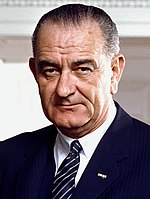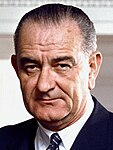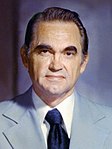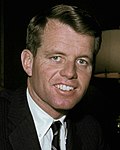1964 United States presidential election in New Jersey
| ||||||||||||||||||||||||||
| ||||||||||||||||||||||||||
 County Results
Johnson 50-60% 60-70% 70-80%
| ||||||||||||||||||||||||||
| ||||||||||||||||||||||||||
| Elections in New Jersey |
|---|
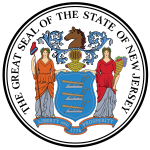 |
The 1964 United States presidential election in New Jersey took place on November 3, 1964. All 50 states and the District of Columbia, were part of the 1964 United States presidential election. Voters chose 17 electors to the Electoral College, which selected the president and vice president.
New Jersey was won overwhelmingly by the Democratic nominees, incumbent President Lyndon B. Johnson of Texas and his running mate Senator Hubert H. Humphrey of Minnesota. Johnson and Humphrey defeated the Republican nominees, Senator Barry Goldwater of Arizona and his running mate Congressman William E. Miller of New York. This is the only time the Democratic nominee won each of New Jersey’s 21 counties, and the second of two times that a Republican failed to win any county after 1912. This is the last time each county in New Jersey voted for the same presidential candidate until Republican President Richard Nixon’s landslide 1972 re-election.
Johnson carried New Jersey in a landslide with 65.61% of the vote to Goldwater’s 33.86%, a margin of 31.75%.[1] Johnson also swept all twenty-one of New Jersey’s counties, the only time a Democratic presidential nominee has ever done so.[2]
Johnson broke 60% of the vote in 15 counties, and 70% in 4: Hudson, Mercer, Middlesex, and Cumberland, besides falling just short of the mark in Essex County, where Johnson received 69.9%. Hudson would be the most Democratic county, giving Johnson 73.5% of the vote. Goldwater’s strongest county was rural Sussex County, where he received 45.2% of the vote to Johnson’s 54.8%.
New Jersey in this era was usually a swing state with a slight Republican lean. But this normal pattern was broken in 1964, as Goldwater’s staunch conservatism led many moderate Northeastern Republicans to view Goldwater as an extremist and defect to the Democrats that year. As Johnson won a massive landslide nationally, normally GOP-leaning New Jersey’s result would even be almost 10% more Democratic than the national average. This was also the last time New Jersey would go to a Democratic candidate for president until 1992, after which the state has always gone Democratic.
Primary elections
[edit]Republican primary
[edit]
| |||||||||||||||||||||
| |||||||||||||||||||||

County Results Lodge Goldwater No Votes
| |||||||||||||||||||||
The Republican primary took place on April 21, 1964. Former Ambassador to the United Nations Henry Cabot Lodge Jr. would win the primary as a write-in candidate, over Barry Goldwater and Richard Nixon
| Candidate | Votes | % |
|---|---|---|
| Henry Cabot Lodge (write-in) | 7,896 | 41.70 |
| Barry Goldwater (write-in) | 5,309 | 28.04 |
| Richard Nixon (write-in) | 4,179 | 22.07 |
| William Scranton (write-in) | 633 | 3.34 |
| Nelson Rockefeller (write-in) | 612 | 3.23 |
| George Wallace (write-in) | 220 | 1.16 |
| Lyndon B. Johnson (write-in) | 84 | 0.44 |
| Total | 18,933 | 100.0 |
Democratic primary
[edit]
| |||||||||||||||||||||
| |||||||||||||||||||||

County Results Johnson Wallace Tie- Johnson/Kennedy No Votes
| |||||||||||||||||||||
The Democratic primary took place on April 21, 1964. Incumbent president Lyndon B. Johnson won the primary on a write-in campaign, as no candidate's names were on the ballot.
| Candidate | Votes | % |
|---|---|---|
| Lyndon B. Johnson (incumbent, write-in) | 4,863 | 82.30 |
| George Wallace (write-in) | 491 | 8.31 |
| Robert Kennedy (write-in) | 431 | 7.29 |
| Henry Cabot Lodge (write-in) | 69 | 1.17 |
| Barry Goldwater (write-in) | 30 | 0.51 |
| Richard Nixon (write-in) | 19 | 0.32 |
| Nelson Rockefeller (write-in) | 3 | 0.05 |
| William Scranton (write-in) | 3 | 0.05 |
| Total | 5,909 | 100.0 |
Results
[edit]| 1964 United States presidential election in New Jersey | |||||
|---|---|---|---|---|---|
| Party | Candidate | Votes | Percentage | Electoral votes | |
| Democratic | Lyndon B. Johnson (incumbent) | 1,867,671 | 65.61% | 17 | |
| Republican | Barry Goldwater | 963,843 | 33.86% | 0 | |
| Socialist Workers | Clifton DeBerry | 8,181 | 0.29% | 0 | |
| Socialist Labor | Eric Hass | 7,075 | 0.25% | 0 | |
| Totals | 2,846,770 | 100.0% | 17 | ||
| Voter Turnout (Voting age/Registered) | 69%/88% | ||||
Results by county
[edit]| County | Lyndon B. Johnson Democratic |
Barry Goldwater Republican |
Clifton DeBerry[5] Socialist Workers |
Eric Hass[5] Socialist Labor |
Margin | Total votes cast | |||||
|---|---|---|---|---|---|---|---|---|---|---|---|
| # | % | # | % | # | % | # | % | # | % | ||
| Atlantic | 50,945 | 65.30% | 25,626 | 32.85% | 1,217 | 1.56% | 231 | 0.30% | 25,319 | 32.45% | 78,019 |
| Bergen | 234,849 | 59.69% | 157,899 | 40.13% | 475 | 0.12% | 242 | 0.06% | 76,950 | 19.56% | 393,465 |
| Burlington | 57,638 | 64.80% | 31,215 | 35.09% | 60 | 0.07% | 32 | 0.04% | 26,423 | 29.71% | 88,945 |
| Camden | 124,620 | 67.09% | 60,844 | 32.75% | 47 | 0.03% | 250 | 0.13% | 63,776 | 34.34% | 185,761 |
| Cape May | 14,943 | 56.65% | 11,390 | 43.18% | 13 | 0.05% | 34 | 0.13% | 3,553 | 13.47% | 26,380 |
| Cumberland | 33,593 | 72.69% | 12,611 | 27.29% | 6 | 0.01% | 5 | 0.01% | 20,982 | 45.40% | 46,215 |
| Essex | 277,042 | 69.88% | 116,172 | 29.30% | 385 | 0.10% | 2,878 | 0.73% | 160,870 | 40.58% | 396,477 |
| Gloucester | 40,305 | 62.93% | 23,702 | 37.00% | 10 | 0.02% | 35 | 0.05% | 16,603 | 25.93% | 64,052 |
| Hudson | 200,051 | 73.55% | 69,515 | 25.56% | 211 | 0.08% | 2,232 | 0.82% | 130,536 | 47.99% | 272,009 |
| Hunterdon | 15,091 | 59.69% | 10,173 | 40.24% | 14 | 0.06% | 5 | 0.02% | 4,918 | 19.45% | 25,283 |
| Mercer | 86,985 | 71.17% | 35,081 | 28.70% | 49 | 0.04% | 99 | 0.08% | 51,904 | 42.47% | 122,214 |
| Middlesex | 151,196 | 70.12% | 63,370 | 29.39% | 840 | 0.39% | 212 | 0.10% | 87,826 | 40.73% | 215,618 |
| Monmouth | 95,320 | 60.69% | 61,367 | 39.07% | 261 | 0.18% | 107 | 0.07% | 33,953 | 21.62% | 157,055 |
| Morris | 73,684 | 57.16% | 55,024 | 42.68% | 125 | 0.10% | 80 | 0.06% | 18,660 | 14.48% | 128,913 |
| Ocean | 36,892 | 57.90% | 25,985 | 40.78% | 764 | 1.20% | 73 | 0.11% | 10,907 | 17.12% | 63,714 |
| Passaic | 113,919 | 63.39% | 63,114 | 35.12% | 2,362 | 1.31% | 304 | 0.17% | 50,805 | 28.27% | 179,699 |
| Salem | 17,846 | 67.23% | 8,682 | 32.71% | 9 | 0.03% | 8 | 0.03% | 9,164 | 34.52% | 26,545 |
| Somerset | 43,659 | 60.41% | 28,416 | 39.32% | 150 | 0.21% | 45 | 0.06% | 15,243 | 21.09% | 72,270 |
| Sussex | 14,349 | 54.77% | 11,836 | 45.18% | 3 | 0.01% | 9 | 0.03% | 2,513 | 9.59% | 26,197 |
| Union | 164,989 | 66.17% | 82,999 | 33.29% | 1,178 | 0.47% | 181 | 0.07% | 81,990 | 32.88% | 249,347 |
| Warren | 19,755 | 69.09% | 8,822 | 30.85% | 2 | 0.01% | 13 | 0.05% | 10,933 | 38.24% | 28,592 |
| Totals | 1,867,671 | 65.61% | 963,843 | 33.86% | 8,181 | 0.29% | 7,075 | 0.25% | 903,828 | 31.75% | 2,846,770 |
Counties that flipped from Republican to Democratic
[edit]- Atlantic
- Bergen
- Burlington
- Cape May
- Gloucester
- Hunterdon
- Monmouth
- Morris
- Ocean
- Salem
- Somerset
- Sussex
- Union
- Warren
Analysis
[edit]As of the 2020 election, this is the last election in which Sussex County, Hunterdon County, and Warren County voted for a Democratic presidential candidate. Union County would not vote Democratic again until 1992. Bergen, Passaic, Ocean, Monmouth, and Cape May Counties would not vote Democratic again until 1996. Somerset County did not vote Democratic again until 2008, and Morris County would not vote Democratic again until 2020.[6] As of 2020, this remains the strongest ever performance by a Democratic presidential nominee in New Jersey, the second strongest ever performance by a nominee of either party after Warren G. Harding in 1920.
See also
[edit]References
[edit]- ^ "1964 Presidential General Election Results – New Jersey". Dave Leip’s Atlas of U.S. Presidential Elections. Retrieved November 25, 2013.
- ^ Thomas, G. Scott; The Pursuit of the White House: A Handbook of Presidential Election Statistics and History, pp. 439-440 ISBN 0313257957
- ^ "Results of the Primary Election Held April 21, 1964" (PDF). Retrieved August 17, 2022.
- ^ "Results of the Primary Election Held April 21, 1964" (PDF). Retrieved August 17, 2022.
- ^ a b Our Campaigns; NJ US President 1964
- ^ Sullivan, Robert David; ‘How the Red and Blue Map Evolved Over the Past Century’; America Magazine in The National Catholic Review; June 29, 2016

